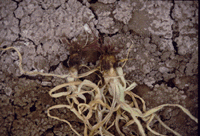
Disease Resistance Genetics and Screening Procedures
The pink root disease of onions is caused by a soil-borne fungus, Phoma terrestris G.R. Hans. (Gorenz, et al, 1949). Pink root occurs wherever onions are grown in warm environments. Once infestation of a soil occurs, it persists for several years at high levels (Jones and Mann, 1963). Only partial resistance has been documented in A. cepa, but all lines developed by the NMSU program carry moderate to high levels of pink root tolerance (Corgan et al., 1997; Corgan and Holland, 1990). The pink root tolerance level in fall-planted 'NuMex' cultivars is adequate for very high yields even on severely infested soils. For later-maturing cultivars and lines, the same level of tolerance is less satisfactory, because plants are in warm soils for longer periods, and disease pressure from the pathogen is greater. There is a need to incorporate higher levels of tolerance into intermediate- and long-day onion cultivars. (Picture to the left is of an onion with Pink Root.)
Little is known about inheritance and/or heritability of onion pink root tolerance/resistance. One study suggests that resistance is controlled by a single recessive gene (Jones and Perry, 1956), while another study indicated the possibility of two recessive genes (Nichols et al., 1965). One of the difficulties in research on pink root inheritance is the apparent large effect the environment has on pink root expression (Gorenz et al., 1949). Based on extensive experience in seedling screening with controlled inoculums and environment, and field screening, pink root resistance should be treated as a quantitatively-inherited trait. Recent estimates of pink-root-resistance heritability suggest that narrow-sense heritability is moderate to high whether populations are tested in the field as bulbs or in the greenhouse as seedlings (Villanueva-Mosqueda, 1996). Those estimates suggest considerable additive variance is available for making improvements in pink root resistance. Numerous breeding lines in the program are segregating for pink root resistance. Heritability of pink root resistance will be determined in those lines. Breeding lines will be screened for pink root resistance as seedlings in the greenhouse and as mature bulbs. In addition, comparisons between direct-seeding and transplanting will be made for evaluating pink root resistance. Inoculums maintenance (Villanueva-Mosqueda, 1996) and preparation (Netzer et al., 1985; Nelson et al., 1987), and screening (Villanueva-Mosqueda, 1996) procedures have been described previously.
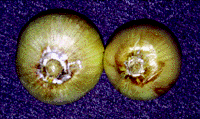
Fusarium basal rot (FBR), caused by Fusarium oxysporum f. sp. cepae, appears initially as leaf yellowing, progresses to root dieback and basal plate degradation, and eventually results in rot of the entire bulb (Wall et al., 1993; Havey, 1995a). The soil-borne organism can remain in the soil for several years, can survive on other Allium species and other plant species, and requires four years of no susceptible hosts to reduce inoculums levels before onions can be planted again (Havey, 1995a). All of those factors make control difficult and expensive to achieve. (Picture to the right is of some onions with F. Basal Rot.)
Numerous long-day, FBR resistant inbreeds have been released by Gabelman at the University of Wisconsin (Goldman, 1996). Currently, no short-day or intermediate-day onion cultivars are reported to have resistance to FBR. Conflicting reports suggest that resistance is governed by one gene (Tsutsui, 1991) or two genes (Bacher, 1989; Bacher et al., 1989). Heritability studies with short-day onion populations determined high narrow-sense heritability for FBR resistance (Villanueva-Mosqueda, 1996). Krueger et al. (1989) developed a greenhouse seedling screening method for detecting FBR resistance. The test was reliable and highly correlated with field screening results. Except for the population used by Villanueva-Mosqueda (1996), the germplasm in this project has not been screened for FBR resistance. Villanueva-Mosqueda (1996) found a strong correlation between pink root resistance and FBR resistance; and germplasm in this project has been screened for pink root resistance. Additional estimates of heritability and gene number for FBR resistance need to be determined for short- and intermediate-day onion populations.
Breeding lines will be screened in the greenhouse as seedlings using the method developed by Krueger et al. (1989). The procedure will be modified as needed. Greenhouse screening results will be confirmed with field screenings of mature bulbs. Populations will be planted in a known F. o. f. sp. cepae infested field or the field will be artificially inoculated. Mature plants will be screened for visual symptoms of basal rot or bulb rot. In addition, harvested bulbs will be screened after curing and several months of storage. In addition to breeding lines, reported short-day A. cepa accessions in the National Plant Germplasm System will be screened for potential sources of resistance to F. o. f. sp. cepae.
Molecular Breeding Techniques
With the advent of molecular biology, techniques are being developed that greatly benefit plant breeding programs. Often those techniques reduce the amount of time and money required for the development of new cultivars. In onions, several molecular breeding techniques have been developed recently that may be beneficial for breeding programs. Probably the most significant advancement has been the use of molecular techniques to identify a particular cytoplasm. With regards to the cytoplasmic male sterility system in onions, plants with N cytoplasm produce viable pollen while plants with S cytoplasm produce nonviable pollen if the restorer locus has the genotype, msms. Cytoplasm determination is critical for the development of inbreeds for hybrid production. Normally, testcrosses would have to be made in order to determine the cytoplasm type. The procedure can take 4 years or more because onion is a biennial with only one generation every two years. Researchers at the University of Wisconsin-Madison (Havey, 1995b) and Texas A&M University (Alcala et al., 1997) have identified molecular marker systems that can identify the cytoplasm type of unknown plants. This technique reduces the need for testcrosses in order to determine a particular cytoplasm. This technique will be incorporated into the New Mexico Onion Breeding Program in the development of inbreeds for hybrid production.
Another possible molecular breeding technique for the identification of genes and inheritance of particular traits would be bulk segregant analysis. Bulk segregant analysis uses random amplified polymorphic DNA (RAPDs) as molecular markers to screen for molecular differences between genotypes with trait differences. Differences in molecular representations between genotypes often indicate genes associated with the trait of interest. The knowledge of the inheritance, genes and number of genes aid in the breeding for that particular trait or traits. This technique has not been used in onions; however, possibilities exist for identification of genes involved in disease resistance, pungency and quality traits.
Bolting

Onion flower induction is caused by low temperature after a juvenile phase of development from seed (Thompson and Smith, 1938). Planting date recommendations for fall-seeded cultivars are based on bolting resistance (Corgan and Holland, 1990). Cultivars that are highly bolting-resistant can be planted earliest, and are the most productive ones when grown in New Mexico (Corgan and Kedar, 1990). Almost all of the fall-seeded cultivars released from this program possess a high level of bolting resistance. Even though much information is known about the physiology of seedstalk production, little information is known about the genetics controlling bolting.
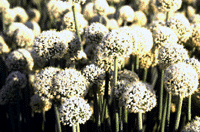
Bolting-resistant plants often develop slower in the fall than bolting-susceptible plants. Some research has speculated on the number of leaves that are required in order to recognize a low temperature stimulus. However, many bolting-resistant breeding lines produce leaf numbers comparable to bolting-susceptible lines. A number of breeding populations in the program are segregating for bolting resistance. Studies will be conducted with those populations in order to determine the genetic control and heritability of bolting resistance.
(Top picture of onion in early flower production. Bottom picture shows onion flowers in full bloom.)
Bulb Quality
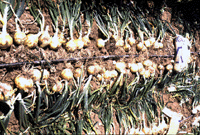
In addition to bulb yield, other bulb characteristics are of interest to the grower. Those characteristics include bulb shape, bulb size, scale color, scale thickness, scale retention, number of scales, bulb firmness, number of growing points, and neck thickness. Onion cultivars are often classified based upon their shape. A bulb which exhibits a shape uncharacteristic for that cultivar can be considered unmarketable. In addition, onion size classification is based upon bulb diameter. Often the highest prices are paid for large diameter bulbs. The scale characteristics are important in the grading, packing, shipping and appearance of the onion. A bulb's firmness is particularly important in the grading and shipping operations. Onion ring processors desire large, single-centered onion bulbs for making onion rings. The neck thickness is important in the bulb curing process and preventing disease entry into the bulb. All cultivars released from this program possess excellent bulb quality.
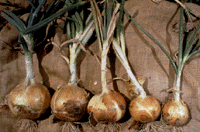
Several studies have been conducted to determine the heritability of bulb size, bulb shape and bulb weight. Most researchers measure bulb shape as an index which is a ratio of bulb diameter to bulb height. The heritability of shape index has been moderate to high (McCollum, 1966; 1968; 1971; Dowker and Fennel, 1974) while the heritability of weight, height and diameter has been low to moderate for long-day onion cultivars (McCollum, 1966; 1968; 1971). Those results suggest that progress can be made readily to achieve the desired onion bulb shape; however, progress for increased bulb size and weight will be more difficult. Even though the heritability of single centers was low, Wall and co-workers (1996) were successful in improving the percentage of single centers by 20% in two short-day onion populations. Heritability studies have not been conducted for scale characteristics (except color), bulb firmness and neck thickness. Several populations in the program are segregating for bulb quality characteristics. Heritability of quality characteristics will be determined in those populations. In addition, quantitative measures of quality will be correlated with qualitative measurements.
(Top picture of onions at harvest time. Bottom picture showing different bulb sizes.)
Soluble Solids

About 10 to 20% of the world's onion production is used in the processing of onions for cooking (Corgan and Kedar, 1990). Onion varieties that are dehydrated and used in processing often possess high levels of dry matter. Dry matter is often determined by measuring the dry weight of the bulb. Dry matter consists of both soluble and insoluble carbohydrates. The soluble solids are in the form of fructose, sucrose, glucose, fructans and other saccharides. The analysis of dry matter can be time consuming and destructive. Several researchers have determined that dry matter content and refractive index (soluble solids) are positively correlated (Mann and Hoyle, 1945; Foskett and Peterson, 1949; Warid, 1952b). The determination of soluble solids is accomplished through the use of a refract meter. In order to measure soluble solids, onion tissue must be pressed to get the onion juice which is measured for percent soluble solids. The percentage of soluble solids varies in different parts of the bulb (Warid, 1952b). The percentage increases from outer to inner bulb scales (Darbyshire and Henry, 1979) and increases from the top to the bottom of the bulb (Warid, 1952b). Kehr (1952) determined that percent soluble solids was positively correlated with bulb specific gravity. Our program hopes to develop simple, quick procedures for specific gravity that correlates with refractive index.
There is great potential for increasing soluble solids in onions. McCollum (1968) determined that soluble solids was highly heritable for a White Sweet Spanish population. In long-storage onions (Simon, 1995) and in short-storage red populations (Warid, 1952a), percent soluble solids was highly heritable in a broad sense. Simon (1995) and Lin et al. (1995) reported large additive variance for soluble solids of long-day, storage onions. McCollum (1968) also observed negative additive correlations between soluble solids and bulb size, weight, height and diameter. Both Lin et al. (1995) and Simon (1995) suggested that the inheritance of soluble solids fit a simple additive-dominance model for long-day, storage onions. Our program has examined soluble solids heritability in a high solids, intermediate-day breeding program. We will continue to determine soluble solids heritability in other high solids populations.
Cold Hardiness

Southern New Mexico is at the northern limit (in terms of low temperature extremes) for the ability to over winter a fall-planted crop. Occasionally severe losses in stand occur due to winter killing of the small plants. Earlier planting in order to produce larger over wintering plants improves plant survival during the winter, but early planting often results in excessive seedstalk production (bolting). The planting window to minimize both bolting and cold injury is about two weeks. Bolting control and/or increased cold-hardiness will expand the planting window and make the crop less susceptible to weather-caused or other planting delays. Greater cold-hardiness will reduce stand and yield losses and permit expansion of the fall-planted crop into colder climatic zones. Cold hardiness has become more important with expansion of the industry into the Uvas and Deming areas where winter plant losses are more severe than in the Mesilla and Hatch valleys.
Of 400 accessions screened for cold hardiness in 1979-80, several were relatively hardy (Peffley, 1981). Some accessions of Japanese origin had 90 percent survival at -13°C. None of the over wintering U. S. cultivars were relatively hardy. The LT 50 (temperature required to kill 50 percent of the population) determined for Yellow Grano and Yellow Granex seedlings in December was about -14°C (Peffley et al., 1981). In field studies, temperatures between -5 and -6°C were the best temperatures for distinguishing between long-day cultivars in their cold hardiness (Bortnes and Opsahl, 1983) . Several studies have determined that older, larger plants are more cold hardy than younger, smaller plants (Peffley et al., 1981; Bortnes and Opsahl, 1983; Rivera-Figueroa, 1991, Warnock et al., 1993).
Crosses were made in 1981 between selected hardy accessions and locally-adapted varieties. Recurrent selections for pink-root resistance, bolting resistance, and other production characteristics since 1981 resulted in several, high-quality lines. However, no selection was done for cold hardiness. No published information is available on heritability for cold hardiness selection in onion. Equipment for hardiness selection is now available, and some preliminary work has been done. The need is to determine heritability of cold hardiness and to concentrate genes for hardiness presumed to be incorporated into the above breeding lines.
Project Computerization
Numerous onion traits have been measured in qualitative terms. Often qualitative evaluations require less time and less data entry than quantitative evaluations. However, qualitative evaluations can be difficult to compare and are unsatisfactory for publication purposes. A need exists to convert many of the qualitative evaluations into quantitative terms, and to establish an onion reference database which will encompass all disciplines related to onions. The database entries should correspond to hard copy articles that students and collaborators will have access to use. Eventually the database collection can be available on a website for others to use. The website for the project would highlight the work, personnel, goals, and cultivars of the project.
Hybrid and Open-Pollinated Variety Comparisons
Most commercial onion seed companies are marketing exclusively hybrid cultivars. They have diminished the number of open-pollinated cultivars offered to onion growers. Hybrid cultivars offer several advantages to the seed company. Primarily, seed companies can protect their germplasm from use by other companies, since the inbreeds used to develop the particular hybrid are trade secrets and are inaccessible to competing companies. In addition, hybrid cultivars are priced higher than open-pollinated cultivars. In some instance, hybrid cultivars may be more uniform and possess higher vigor than open-pollinated cultivars. With these reported benefits, comparisons in plant vigor and bulb yield should be made between hybrid and open-pollinated varieties. A multi-year, fall-planted variety trial will be conducted tom compare plant vigor and yield between hybrid and open-pollinated varieties. In addition, the costs and returns of developing and producing open-pollinated and hybrid varieties have not been determined. A study in collaboration with Dr. Jim Libbin, Department of Agricultural Economics and Agricultural Business will examine the costs and returns of onion seed production in New Mexico and compare the costs and returns of developing, producing, and marketing hybrid and open-pollinated onion varieties.

